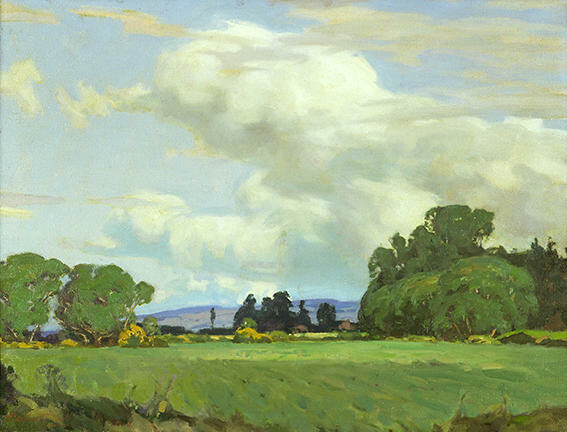B.
Port Hills From Bryndwr by Archibald Nicoll
Collection
This article first appeared as 'Archibald Nicoll's Colourful Life' in The Press on 5 May 2015.
Between the two world wars, Archibald Nicoll—a man of strong personality and decided opinions—was an influential figure in Christchurch art circles. He was director of the Canterbury College School of Art from 1920-8; a president of the Society of Arts; served on the management committee of the National Art Gallery; and was a prize-winning painter whose work was highly sought after by collectors and acquired by public galleries in each of the main centres.
Arguably, though, history has not served Nicoll particularly well. The story of Christchurch art in the first half of the twentieth century has often been pitched as a battle between progressive forces and conservative institutions, set against a largely indifferent public sphere. As a member of the conservative establishment (he advised against accepting Frances Hodgkins's Pleasure Garden into the city's collection, for example), Nicoll comes out on the 'wrong' side of modernism's historical ledger. Yet his story is more nuanced than that, and his work far more interesting.
Nicoll was born to an emigrant Scottish family in Lincoln on the Canterbury plains in 1886. He became a shipping clerk in Christchurch and went to art school at night, studying under the notable painter Sydney Lough Thompson. After five years he left the shipping firm and moved to Auckland, teaching at the Elam School of Fine Arts and saving money for a ticket to Europe, where he studied painting in London and Edinburgh. He won prizes for his work, and exhibited in several important Scottish exhibitions and at the Royal Academy in London. He was just beginning to establish a name for himself when war broke out. He sailed back to New Zealand, got married, and returned to Europe as a soldier.
The war changed everything for him. In the thick of the fighting on the Somme, he was seriously wounded, and his leg was amputated at the thigh. After being demobilised in 1918, he never returned to Britain and instead made a life as an artist in New Zealand.
In the 1930s and 40s Nicoll was renowned as a portrait painter, specialising in depictions of men; boardroom portraits, as they have been described. It is his landscape paintings, however, which constitute his particular achievement. The places they picture are nowhere significant: a curve of road, a stand of trees, a fence line in snow. But there is a distinctive quality of light and air which emanates from the work; a certain rough modelling which reveals the world in motion. His observation of the fall of sunlight and the pattern of shadow in the natural world retains its charge. There are correspondences between Nicoll's landscape works and the Scottish post-impressionists known as the Colourists, who painted out of doors and were similarly concerned with atmospheric effects.
With his disability, Nicoll could not walk far; most of his landscapes were painted close to roads. Port Hills from Bryndwr was painted late in his life, at a time when that suburb was a hive of activity as extensive new residential subdivisions were being developed from former farmland and market gardens. Nicoll travelled to the city's limits not to depict its progress but to look out from its edge into the rural hinterland; a timeless scene in which light falls from under scudding clouds and the distant hills are enveloped in a purple haze.

